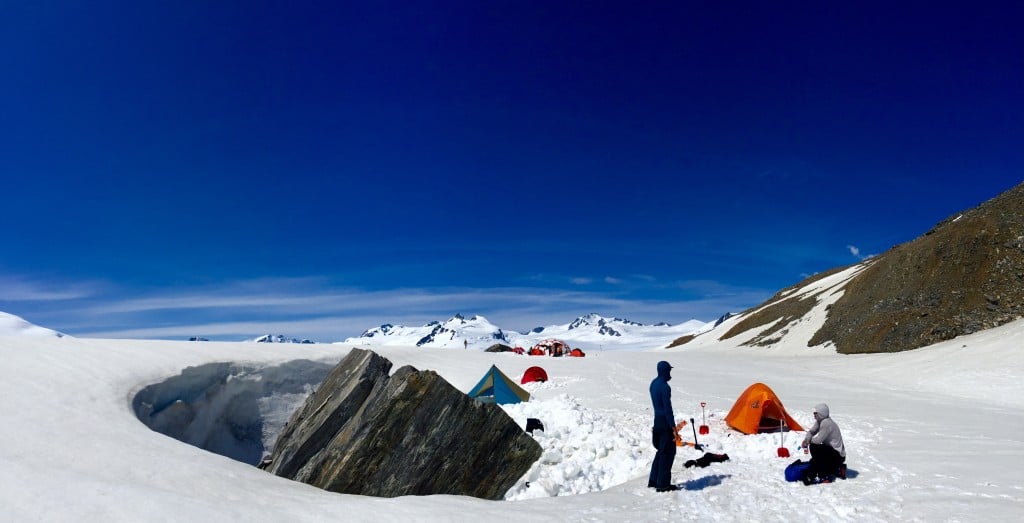If you were to ask most people which peak is the highest in Wyoming, their answer would probably be "the Grand Teton!" With over 6,000 feet of prominence, the Grand is awe-inspiring. However, hidden deep within the wild Wind River Range lies one of Wyoming's best kept secrets.
Standing at 13,809 feet, with 7,000 feet of prominence, surrounded by glaciers on all sides and fortified by gnarled rock spires, Gannett Peak is Wyoming's premier mountain and one of the most remote climbs in the United States.
Gannett Peak is not the traditional "mountain of a mountain" at first glance. The mountain is not even visible until you are on its slopes. With an approach of at least 20 miles from any direction, that view does not come easily. With the exception of Denali in Alaska, Gannett Peak is the most isolated and, arguably, one of the most difficult high-point climbs in the United States.
If you were to attempt a similar challenge, such as Mt. Rainier, you would be dropped promptly at its base and most likely taken to the summit by a guide (since personal permitting is difficult to acquire) along an established route and run into numerous other groups along the way. The beauty of a mountain like Rainier comes from its intrinsic splendor as a lone peak that dominates the horizon around it. For a full-fledged mountaineering backcountry adventure, I might suggest Gannett Peak instead, where the beauty flows from the quiet, haunting serenity of a deep and lost land in the heart of the Rocky Mountains.
Our journey began in Pinedale, Wyoming where we traveled 25 miles through pristine Wind River country. Our route took us past seemingly forgotten alpine lakes, vivid green fields filled with flowers, and deep basins guarded by majestic spires on all sides. Near the end of the first day, while laying on an alpine beach with the mountains sprawled before me, I felt a call that beckoned me further up and further into that vast wilderness and perhaps if I answered, this journey could go on forever.
The following day we trudged over Bonney Pass, where we gained then lost 1,400 feet of elevation as we dropped into the glacier valley where Gannett Peak first becomes visible. As we crested the top of Bonney Pass and beheld Gannett for the first time, we immediately recognized the dramatic beauty of the mountain. The towers around the mountain appeared as broken shards of glass hoping to tear holes through an immaculate blue sky. In the midst of these aggressive yet fragile towers draped with white blankets of ice on all sides stood one unmoving and resolute figure. With its broad, sweeping summit, Gannett seemed to draw a line in the sky between reality and dreams.
After reaching the bottom of Bonney Pass, the isolation only intensified. The glacier-filled basin created an illusion that this strange but lovely new world stretched on forever until it was abruptly interrupted by mountains on all sides. All that could be heard while on the ice was the rapid breathing of my fellow team members and the occasional groan from deep within the bowels of the glacier. As we continued across the glacier, we determined that the glacier was either excited to have the company or had been waiting far too long for its next meal ... a frightening thought as we navigated crevasse after crevasse.
The main technical challenge on Gannett is the bergschrund (a large crevasse between the glacier and the rock of the mountain) near the top of the Gooseneck Glacier. In good conditions, the bergschrund is easily navigated by a sound snow bridge; however, late in the season the snow bridge is mostly melted away, exposing its most daunting areas. Fortunately, there was still enough ice spanning the crevasse to allow a bold lead climber to take a rope up above the glacier and set up a belay station to bring up the remaining crew. With an ice axe in each hand, I felt as if there should be cameras on all sides of me recording the next Hollywood blockbuster.
Once through the Gooseneck Glacier, it was a simple hike along the exposed summit ridge to the top and wow, what a view! The realization of just how far we had come and what we'd accomplished began to set in on the summit. The route finding, couloir climbing, and steep, exposed sections that led to an airy summit ridge were reminiscent of a much larger, more exotic peak. We were able to do it without guides or permits, or seeing other people. Even with 100 summits every year, it still feels as if we might have been the first to ever stand on top of Gannett Peak.
"It feels like I'm finally doing the things I've always talked about doing," said fellow expedition member Kirk Rasmussen as we entered the still space between sky and earth.
Gannett Peak is an excellent journey for those with mountaineering experience, and a perfect introduction to backcountry expeditions. So next time you have the free time, go ahead and dive into the woods, put some dirt on the boots, park yourself on top of the world and take pride in being remote and unyielding.
Learn the skills to go on your own backcountry expeditions. Explore courses with NOLS.
Are you a NOLS alum? Check out the Gannett Peak Mountaineering Expedition on our Alumni Trips page.










